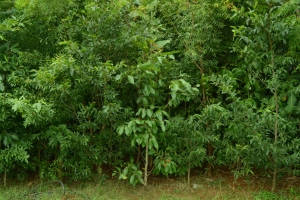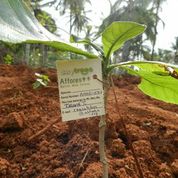 Imagine waking up to the cries of sparrows, the smell of flowers, and blinding greenery. Imagine waking up next to a natural forest instead of a concrete jungle that is swiftly eating into the urban green cover. One Bangalorean has been successfully turning that dream into reality. Shubhendu Sharma, a former engineer with Toyota, in a bid to overturn the curse of unfettered urban development, started Afforestt that helps grow a completely natural forest in your backyard!
Imagine waking up to the cries of sparrows, the smell of flowers, and blinding greenery. Imagine waking up next to a natural forest instead of a concrete jungle that is swiftly eating into the urban green cover. One Bangalorean has been successfully turning that dream into reality. Shubhendu Sharma, a former engineer with Toyota, in a bid to overturn the curse of unfettered urban development, started Afforestt that helps grow a completely natural forest in your backyard!
Afforestt, started in 2011, is a for profit social enterprise that provides end-to-end services for creating a natural, wild, maintenance free, native forests.
A chance rendezvous with well-known Japanese naturalist Akira Miyawaki at the Toyato plant he was working in, introduced Sharma to the idea of growing a man-made forest. Enthralled by the human backed ability to create a natural ecosystem with the help of existing natural materials, Sharma decided to emulate the Miyawaki method, with slight modifications, to suit Indian needs.
“The Miyawaki method states that every land has the potential to grow the native species of plants. Native plants introduced after the soil is surveyed and richened by adding nutrients it lacked, can convert the plot of land into a forest,” says the 28-year-old.
Before embarking on the project, Sharma did ample research, and experimented with pilot projects. “Being a relatively unheard concept, I had to start researching from scratch. There were no parameters against which I could measure my ideas,” he adds. However, he soon created a mini forest in his hometown of Uttarakhand. “That successful first attempt gave me immense confidence to start Afforestt,” he says.
Sharma and his team, before creating a forest anywhere, take on a six-step method that includes, taking a three-sample soil survey, identifying lack of nutrients in the soil, taking bio mass survey, and most importantly investigating the surrounding areas for native species that can be planted.
The team then prepares saplings based on the potency of the soil.
“To make sure that the forests are sustainable, we go for a multi-level forest, where a ten feet tree is planted with 30 feet high trees,” he adds. This “organized chaos”, as he describes it, helps increase the survival rate of the forests by two percent.
After plantation, the first two to three years are the hardest. “Once the saplings or trees are planted, they have to be maintained properly for the first two or three years. They have to be watered regularly. But after the teething period, the forest grows on its own, without much maintenance,” he explains.
Sharma has also taken the proverbial ‘lack of space’ complaint of urban citizens into account. If you have 1,000 sq metres, Sharma has a forest for you. “We plant three saplings in a square metre, and for one square foot we charge Rs 150,” he says. Interestingly, with double-edged method of native species emphasis, and rigorous soil survey, Sharma’s forests are 30 times denser and grow 10 times faster than a normal forest.
Sharma and team have already planted more than 44,000 trees, in more than 33 forests across the country. “In Bangalore we have created forests in 11 homes and farms. We have also helped build forests in Delhi, Indore, Tamil Nadu, Mumbai, Nainital among others,” says Sharma.
The story was first published here


